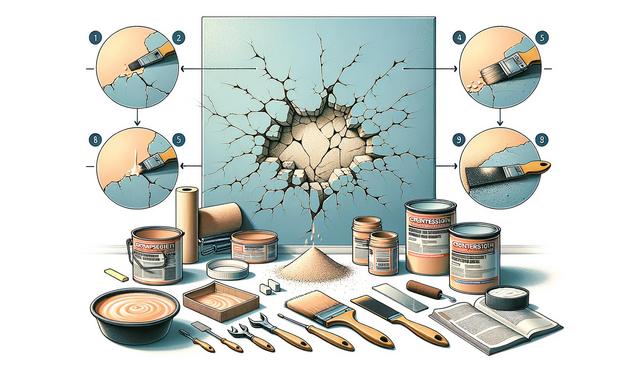DIY Wall Crack Repair: 5 Affordable DIY Ways to Create Perfect Walls.
Whether you’re dealing with minor cracks or more noticeable damage, you’ll find a suitable solution to fit your budget and needs. Discover ways to enhance the appearance of your walls with these easy and affordable solutions!

1. Understanding the Types of Wall Cracks
Before jumping into repairs, it’s important to understand what kind of cracks you’re dealing with. Cracks in new house walls are common as the building settles, but not all cracks are the same. Some may be cosmetic, while others could indicate structural issues. Common types include:
- Hairline cracks in drywall – often caused by foundation settling or changes in humidity.
- Diagonal cracks – may suggest foundation movement or shifting.
- Cracks in basement floor new construction – these can develop as concrete cures or if the slab wasn’t poured properly.
- Vertical or horizontal cracks – these could appear in both walls and slabs and may need further inspection.
Identifying the nature and cause of the crack helps determine the appropriate solution. If you notice extensive damage or suspect moisture issues, you might want to consult waterproofing services before doing the repairs yourself.
2. Using Joint Compound for Hairline Cracks
For minor cracks, especially in drywall, joint compound offers a simple and effective solution. These types of cracks are common in new home cracks in drywall as the structure adjusts. Here’s a straightforward process:
- Clean the crack using a small brush or vacuum to remove dust and debris.
- Apply a thin layer of joint compound using a putty knife.
- Smooth the surface and let it dry completely.
- Sand lightly and apply a second coat if necessary.
- Finish by painting over the repaired area.
This method is affordable and ideal for hairline cracks that aren’t caused by deeper structural issues. It’s a go-to solution for homeowners wanting a quick aesthetic fix.
3. Patching with Mesh Tape and Compound for Larger Cracks
For larger or recurring cracks, especially those in corners or along seams, combining mesh tape with joint compound adds durability. This method is particularly useful for cracks in new house slab walls or drywall that have widened over time. Follow these steps:
- Clean and widen the crack slightly so the compound can bond better.
- Apply mesh tape over the crack to bridge the gap.
- Cover the tape with joint compound, feathering the edges.
- Allow it to dry, then sand and reapply if necessary.
- Prime and paint for a finished look.
This approach strengthens the repaired area and prevents the crack from reappearing, making it a wise choice for areas prone to movement or minor settling.
4. Filling Deep Cracks with Flexible Caulk
In areas where cracks are deeper or where movement is expected—such as around windows, doors, or basement floors—using a flexible caulk is often more effective than rigid fillers. Cracks in basement floor new construction or around the foundation may benefit from this method. Here’s how to apply it:
- Clean the crack thoroughly and dry the surface.
- Use a caulking gun to apply flexible latex or silicone caulk.
- Smooth the bead with a caulking tool or damp finger.
- Let it cure as per the manufacturer’s instructions before painting.
This type of repair allows for minor shifts without cracking again. It’s also water-resistant, which adds a layer of protection, especially in areas where moisture could be a concern. When dealing with persistent dampness or leaks, consider consulting waterproofing services to address the root cause.
5. Preventing Future Wall Cracks
While DIY repairs are effective, prevention is the long-term solution. Many cracks in new house walls, slabs, or basement floors stem from external factors such as shifting soil, poor drainage, or inconsistent humidity. To reduce future damage:
- Control indoor humidity levels to prevent drywall expansion and contraction.
- Seal exterior gaps and foundation to keep moisture out.
- Ensure proper grading around the home to direct water away from the foundation.
- Inspect for cracks regularly and address them early.
Taking these preventative steps can help maintain your repairs and minimize the likelihood of recurring damage. For new homes, especially, early intervention is key to avoiding larger issues down the road. When signs of water intrusion or foundation movement appear, waterproofing services can provide further protection and peace of mind.
Conclusion: Restore and Maintain Your Walls with Confidence
Cracks in your walls—whether in a new home or older structure—don’t have to be a cause for concern. With these affordable and practical DIY solutions, you can tackle common problems like cracks in new house drywall or basement floor flaws quickly and effectively. By understanding the cause, choosing the right repair method, and implementing preventative measures, you’ll be able to maintain the beauty and stability of your walls for years to come. And if you ever run into moisture-related issues, don’t hesitate to explore reliable waterproofing services for added protection.